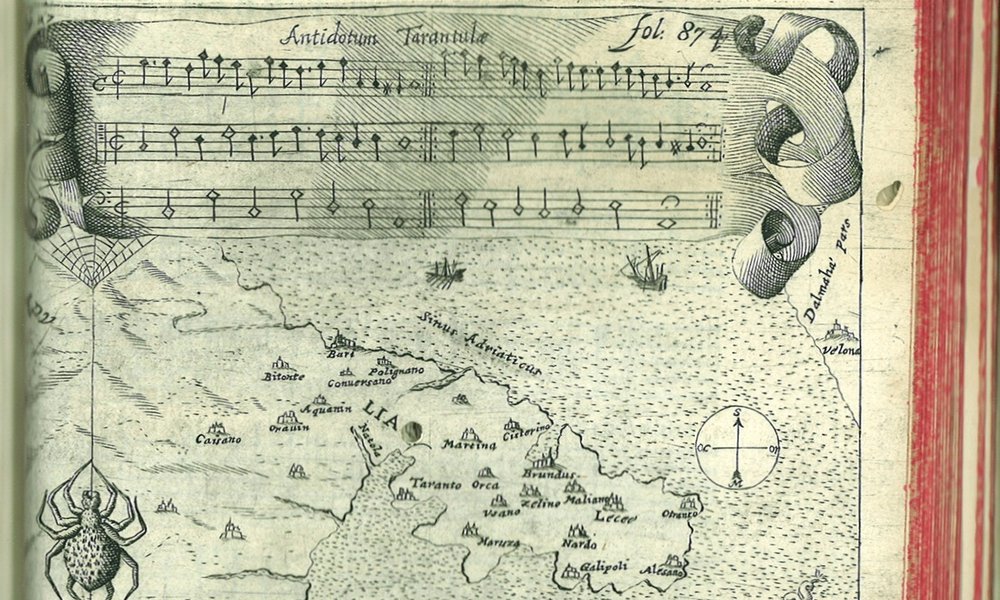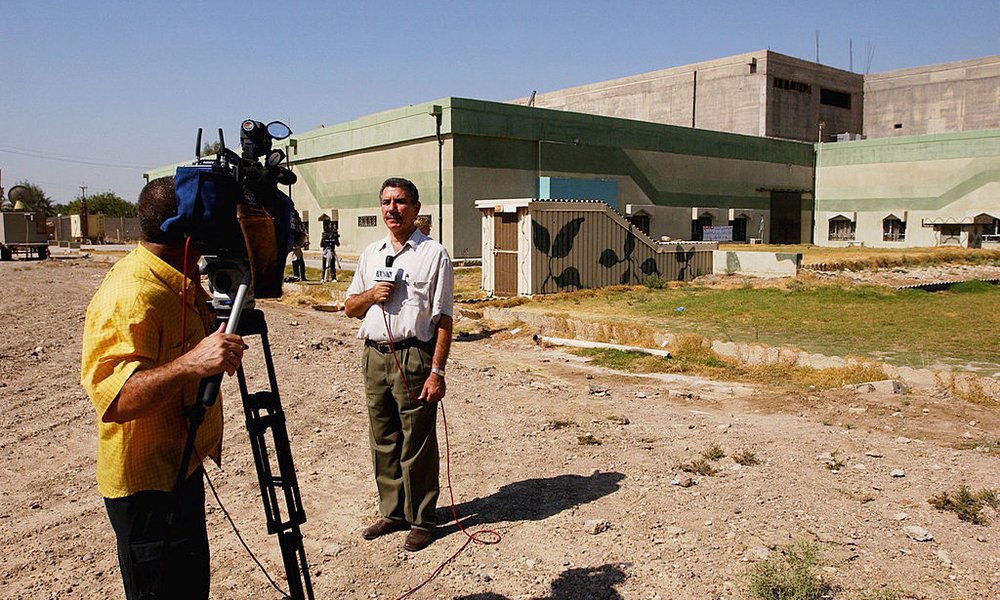How 20th-century colonial politics shaped the story of Tutankhamun's tomb
by Professor Christina Riggs
16 Jul 2019
The discovery of Tutankhamun’s tomb was never photographed. This will come as a surprise to archaeology enthusiasts familiar with photographs like the one below, often identified as Howard Carter caught in the moment of opening the tomb in November 1922.
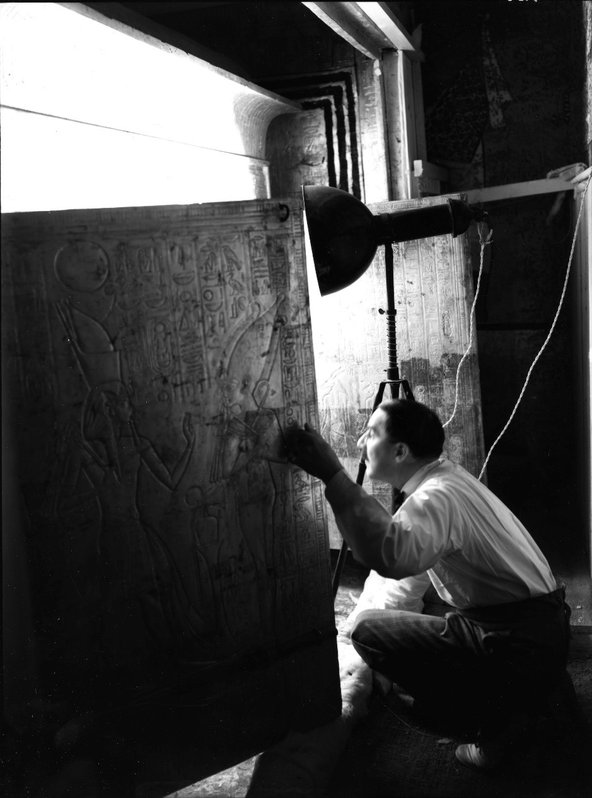
In fact, the photo dates to early January 1924, the second winter Carter and his colleagues spent working in the jam-packed tomb. We might imagine that Howard Carter is kneeling to look in awe at the face of Tutankhamun, or at least something suitably gold and glorious. In fact, Carter was looking at the still-closed doors of another shrine inside and he was dazzled, not by gold, but by (as he put it) the “mystic mauve” glow of photographic reflectors just out of shot. Held by unnamed Egyptian co-workers, those reflectors were required by the tomb’s official photographer, Harry Burton, to bounce electric lamplight around the cramped, dark space and yield the desired effects of light and shadow.
The first global media sensation
Why was Burton – a photographer chosen by Carter for the cool clarity of his record shots – staging such self-consciously dramatic photos as work on the tomb progressed? The answer was that the tomb had become a media sensation. It was arguably the first news story with a global impact, thanks to recent advances in print journalism, telegraph technology and radio communication. Its discovery also served as a ‘good news story’, at a troubled time in history.
The First World War had ended in defeat for the Ottoman Empire, leaving much of the Middle East in turmoil. Egypt had been occupied by British imperial forces since 1882, in a 'veiled protectorate' whose veil came off with the outbreak of war. Egyptians hoped the war’s end would bring independence, but the British government wanted to keep control of the profitable and strategically important Suez Canal. By 4 November 1922, when Howard Carter’s Egyptian excavators found the first step leading down to the tomb of Tutankhamun, Britain had given Egypt partial independence, with the British in charge of the Canal, British troops still in place, and British ‘advisors’ in every Egyptian ministry. Independence leader Sa’ad Zaghloul returned from exile, and the country geared up for its first parliamentary elections, which would make Zaghloul prime minister in 1923.
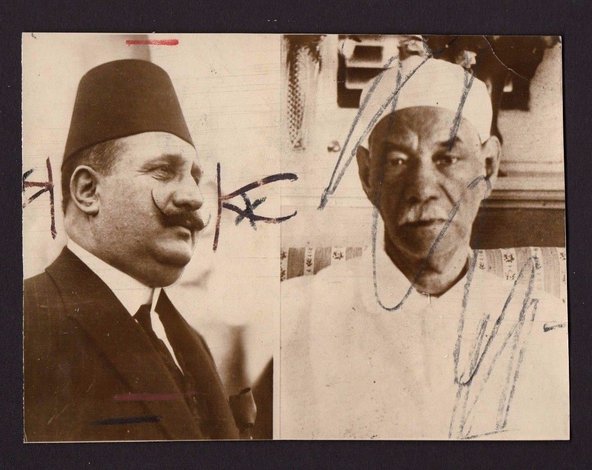
Meanwhile, tourism to Egypt, so popular before the war, started to pick up again as the political situation stabilised and post-war economies boomed. This was the background for the unexpected reappearance of an 18th-dynasty pharaoh almost nobody had heard of: Tutankhamun, a minor king who had died aged 18 or so, around 1323 BC. As it turned out, he would be more important in modern times than he’d ever been in his own.
Owning ancient Egypt
The story of a newly discovered – and intact – burial in the Valley of the Kings would always have made headlines. But faster travel and communication technologies meant those headlines were bigger and spread faster than ever before.
For decades, archaeologists had used the press to publicise their work and raise funds, so Howard Carter and his sponsor, the Fifth Earl of Carnarvon, knew that they could turn the discovery to their advantage. With his eye on the bottom line, Carnarvon sold exclusive story and photograph rights to the London Times, reserving the film rights for himself, in case Hollywood came calling.
Harry Burton arrived just before Christmas, to take photographs in the ‘untouched’ antechamber of the tomb – which by then had been open for several weeks, visited by a dozen or more people, and rigged for electric lighting. Burton’s photography fixed the tomb in the public eye: two life-size guardian statues, their limbs coated with black resin and gold leaf, flanked the plaster-sealed opening to the rest of the tomb.
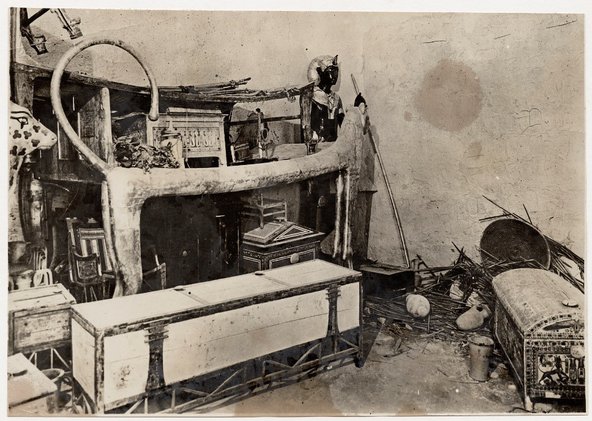
The Times published Burton’s first photographs on 30 January 1923 and sold them on to major newspapers around the world, but controversy was already stirring. Other newspapers were angered by Carter and Carnarvon’s deal with the Times, not least the Egyptian press forbidden access to the biggest story of the day, in their own backyard. Carter also started to clash with the Egyptian antiquities service, which was legally in charge of the excavation and had a right to inspect progress.
Like Carnarvon, Carter was used to the old ways of doing things, when Britain held all the cards. Now, the antiquities authorities answered to the Egyptian government and expected the finds from this unique tomb to stay in Egypt, not sold to museums in Britain and America. Letters and diaries written by British members of the excavation dismissed with colonial arrogance the idea that any modern Egyptian really cared about archaeology – even as the country’s poets and playwrights praised Tutankhamun as an ancestor who had come back to see Egypt reborn.
A few weeks after Burton took the dramatic photograph of Carter kneeling before the burial shrines, the British excavators refused to do any further work for the antiquities service, which promptly changed the lock on the tomb’s gate. More than a year would pass before Carter resumed work, coaxed back in part by a more conciliatory Egyptian government, put in place after Britain forced Zaghloul from power. Empire never ends easily.
The Tutankhamun turn
Carter continued to work on the tomb until 1933, with Burton returning regularly to photograph hundreds of objects as they were removed, repaired and catalogued. In 1929, Carter finally accepted that neither he nor the Carnarvon family would receive any of these objects for their own collections, or for British and American museums. The gold mask, the guardian statues, and all the other marvels from the tomb – made famous by Burton’s photos in the press – instead became the star exhibits of the Egyptian Museum in central Cairo. Tutankhamun was a test case that changed generations of practice centred around Western privilege in archaeology, and many archaeologists were uneasy with it.
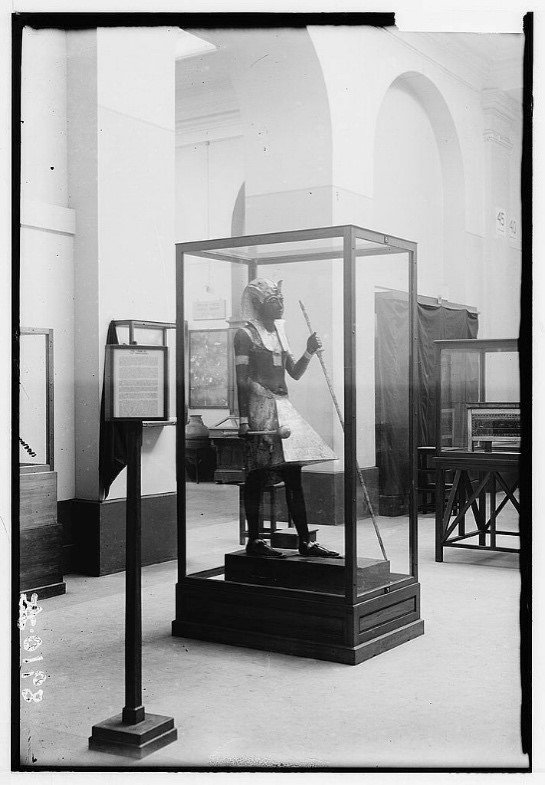
As the Second World War loomed, Tutankhamun no longer made headlines. All the fuss started to look a little old-fashioned and, after Carter’s death in 1939, few scholars were interested in the tomb or its artefacts. Relations between Britain and Egypt disintegrated in the 1950s, when General Nasser came to power. But when Egypt needed to gather international support for the construction of the Aswan High Dam, it turned to Tutankhamun for cultural diplomacy.
A selection of small objects from the tomb toured the United States in the early 1960s, when President Kennedy pledged American support for a UNESCO-backed effort to relocate ancient temples that the Dam would flood. As salvage efforts gathered pace, Egypt next agreed to lend Tutankhamun’s gold mask to Paris, in gratitude for French help in securing UNESCO’s support. More museums clamoured for their own chance to show the mask and other glittering objects from the tomb and Egypt began a diplomatic dance, using loans of the Tutankhamun treasures to position itself on the world stage. Tokyo, London, a seven-city tour of the United States, a quick stop in Canada, then the Soviet Union and West Germany: Tutankhamun’s treasures toured for nearly a decade in the 1970s and early 1980s, until damage to a wooden statuette led Egypt to call time on further loans.
At almost every venue of those exhibitions, Harry Burton’s photographs were used to illustrate the history of the excavation, turning Howard Carter into a hero figure once again. The early 20th century was framed as a ‘golden age’ of archaeology – but it was golden only because of Egypt’s colonial status, which had allowed foreign excavators to fill their own collections and museums with Egyptian antiquities.
These photographs continue to be used across the internet and social media today – and in museum exhibitions. Egypt has lent 150 objects from the tomb to a new world tour, with. promotional material making ample use of the original photographs taken by Burton and the London Times. Without any caption, copyright, or credit, however, the photographs offer little more than set dressing. They signal ‘Tutankhamun’ while evoking that ‘golden age’ that should, by now, have tarnished. This seems to be confirmed by a publicity stunt held recently in London, when blacked-up actors – meant to represent the guardian statues – appeared in Trafalgar Square, Pall Mall, and outside Buckingham Palace.
Tasteless as the stunt was, it did put Tutankhamun where Carter, Carnarvon and many other British people at the time thought he belonged: in the heart of the British Empire. The exhibition organisers insist that this tour is the last time Tutankhamun’s treasures will be seen outside of Egypt. If only it were the last time the excavation would be viewed through the nostalgic lens of archaeology and Empire.
Professor Christina Riggs is a Fellow of All Souls College, Oxford and, from 1 October 2019, Chair in the History of Visual Culture at Durham University. She received a Mid-Career Fellowship in 2015. Her book Photographing Tutankhamun: Archaeology, Ancient Egypt, and the Archive is the first study of the photographic archive formed during the 10-year clearance of the tomb, tracing the history of these evocative images through the 20th century up to the present day.
Read more at her blog, Photographing Tutankhamun, or follow her on Twitter, @photograph_tut.
